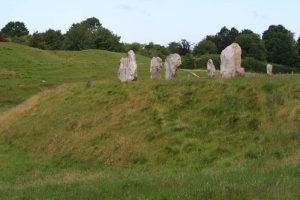Avebury, Delphi, Ryoanji and Salisbury Cathedral Cloister are sacred places. But are they also gardens? Yes: they are enclosed outdoor spaces; they were designed to be beautiful; they were not made for functional horticulture.
Sun, shadows, water, plants and structures are intrinsic to their design. Ryoanji, you might say, is a dry garden. Yes it is, but moss grows around the famous stones and the play of tree shadows on the gravel is part of the fascination.
According to Wikipedia “Holiness, or sanctity, is the state of being holy or sacred, that is, set apart for the worship or service of gods. It could also mean being set apart to pursue (or to already have achieved) a sacred state or goal, such as Nirvana. It is often ascribed to people, objects, times, or places.” I have one quibble with this definition: the Buddha did not recognize a god and Buddhism is the world religion which has had the most influence on garden design.
In a demythologised sense, if you wish, I believe that sacredness remains a vital concern in garden design. We want to have places which are ‘set apart’ from the everyday world of bustling stress, which fill the soul and solace the flesh. I wish those who plan suburban subdivisions and housing estates had an appreciation of how space can be ‘set apart’ and yet connected.


ICOMOS is the International Council on Monuments and Sites dedicated to the conservation of the world’s monuments and site.
In December 1982 ICOMOS adopted The Florence Charter of 1981 on Historic Gardens http://www.international.icomos.org/charters/gardens_e.pdf to complement the Venice Charter of 1964 on the Conservation and Restoration of Sites and Monuments. http://www.icomos.org/venice_charter.html
Article five of the charter describes the historic garden as;
“As the expression of the direct affinity between civilisation and nature, and as a place of enjoyment suited to mediation and repose, the garden thus acquires the cosmic significance of an idealised image of the world, a “paradise” in the etymological sense of the term, and yet a testimony to a culture, a style, an age, and often to the originality of a creative artist.”
Article eight says;
“A historic site is a specific landscape associated with a memorable act, as for example, a major historic event, a well-known myth; an epic combat, or the subject of a famous picture.”
Also of interest to everyone with a concern for green spaces of the urban and suburban kind is clause four of the dutch Declaration of Arhem http://library.wur.nl/speccol/decarnhem.html;
4)”Green monuments call for an integral, interdisciplinary, coherent approach to be taken by owners, stewards, governing boards, garden and landscape designers, historians, urban planners, architects, ecologists, botanists and trained gardeners.”
Many thanks for the definition of Historic Garden. Having official support makes me feel better! I read the definition as including Stonehenge and the Avebury Stone Circle but I am doubtful about either ‘most people’ or the people who framed the definition agreeing with me.
Although not listed in clause two, see the definition of Green monuments in clause one of the Declaration of Arnhem;
“Green monuments (historic monumental compositions of greenery) from an integral part of Dutch cultural history and the Netherlands can pride itself on a unique tradition of man-made landscapes in which green monuments are preeminently the outcome of the interpenetration of nature and culture.”